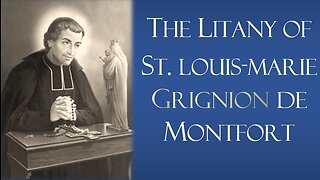Episode 1051: Sts. Louise de Marillac and Clement Mary Hofbauer
Born near Meux, France, Louise lost her mother when she was still a child, her beloved father when she was but 15. Her desire to become a nun was discouraged by her confessor, and a marriage was arranged. One son was born of this union. But Louise soon found herself nursing her beloved husband through a long illness that finally led to his death.
Louise was fortunate to have a wise and sympathetic counselor, Francis de Sales, and then his friend, the bishop of Belley, France. Both of these men were available to her only periodically. But from an interior illumination she understood that she was to undertake a great work under the guidance of another person she had not yet met. This was the holy priest Monsieur Vincent, later to be known as Saint Vincent de Paul.
At first, he was reluctant to be her confessor, busy as he was with his “Confraternities of Charity.” Members were aristocratic ladies of charity who were helping him nurse the poor and look after neglected children, a real need of the day. But the ladies were busy with many of their own concerns and duties. His work needed many more helpers, especially ones who were peasants themselves and therefore, close to the poor and able to win their hearts. He also needed someone who could teach them and organize them.
Only over a long period of time, as Vincent de Paul became more acquainted with Louise, did he come to realize that she was the answer to his prayers. She was intelligent, self-effacing, and had physical strength and endurance that belied her continuing feeble health. The missions he sent her on eventually led to four simple young women joining her. Her rented home in Paris became the training center for those accepted for the service of the sick and poor. Growth was rapid and soon there was the need for a so-called “rule of life,” which Louise herself, under the guidance of Vincent, drew up for the Daughters of Charity of St. Vincent de Paul.
Monsieur Vincent had always been slow and prudent in his dealings with Louise and the new group. He said that he had never had any idea of starting a new community, that it was God who did everything. “Your convent,” he said, “will be the house of the sick; your cell, a hired room; your chapel, the parish church; your cloister, the streets of the city or the wards of the hospital.” Their dress was to be that of the peasant women. It was not until years later that Vincent de Paul would finally permit four of the women to take annual vows of poverty, chastity and obedience. It was still more years before the company would be formally approved by Rome and placed under the direction of Vincent’s own congregation of priests.
Many of the young women were illiterate. Still it was with reluctance that the new community undertook the care of neglected children. Louise was busy helping wherever needed despite her poor health. She traveled throughout France, establishing her community members in hospitals, orphanages and other institutions. At her death on March 15, 1660, the congregation had more than 40 houses in France. Six months later Vincent de Paul followed her in death.
Louise de Marillac was canonized in 1934 and declared patroness of social workers in 1960.
Clement Mary might be called the second founder of the Redemptorists, as it was he who carried the congregation of Saint Alphonsus Liguori to the people north of the Alps.
John, the name given him at Baptism, was born in Moravia into a poor family, the ninth of 12 children. Although he longed to be a priest, there was no money for studies, and he was apprenticed to a baker. But God guided the young man’s fortunes. He found work in the bakery of a monastery where he was allowed to attend classes in its Latin school. After the abbot there died, John tried the life of a hermit, but when Emperor Joseph II abolished hermitages, John again returned to Vienna and to baking.
One day after serving Mass at the Cathedral of St. Stephen, he called a carriage for two ladies waiting there in the rain. In their conversation they learned that he could not pursue his priestly studies because of a lack of funds. They generously offered to support both John and his friend Thaddeus, in their seminary studies. The two went to Rome, where they were drawn to Saint Alphonsus’ vision of religious life and to the Redemptorists. The two young men were ordained together in 1785.
Newly professed at age 34, Clement Mary, as he was now called, and Thaddeus were sent back to Vienna. But the religious difficulties there caused them to leave and continue north to Warsaw, Poland. There they encountered numerous German-speaking Catholics who had been left priestless by the suppression of the Jesuits. At first they had to live in great poverty and preach outdoor sermons. Eventually they were given the church of St. Benno, and for the next nine years they preached five sermons a day, two in German and three in Polish, converting many to the faith. They were active in social work among the poor, founding an orphanage and then a school for boys.
Drawing candidates to the congregation, they were able to send missionaries to Poland, Germany, and Switzerland. All of these foundations eventually had to be abandoned because of the political and religious tensions of the times. After 20 years of difficult work, Clement Mary himself was imprisoned and expelled from the country. Only after another arrest was he able to reach Vienna, where he was to live and work the final 12 years of his life. He quickly became “the apostle of Vienna,” hearing the confessions of the rich and the poor, visiting the sick, acting as a counselor to the powerful, sharing his holiness with all in the city. His crowning work was the establishment of a Catholic college in his beloved city.
Persecution followed Clement Mary, and there were those in authority who were able for a while to stop him from preaching. An attempt was made at the highest levels to have him banished. But his holiness and fame protected him and prompted the growth of the Redemptorists. Due to his efforts, the congregation was firmly established north of the Alps by the time of his death in 1820.
Clement Mary Hofbauer was canonized in 1909. His liturgical feast is celebrated on March 15.
Reflection
Clement Mary saw his life’s work meet with disaster. Religious and political tensions forced him and his brothers to abandon their ministries in Germany, Poland, and Switzerland. Clement Mary himself was exiled from Poland and had to start all over again. Someone once pointed out that the followers of the crucified Jesus should see only new possibilities opening up whenever they meet failure. Clement Mary encourages us to follow his example, trusting in the Lord to guide us.
-
 24:07
24:07
CatholicReboot
1 year agoEpisode 359: St. Margaret Mary Alacoque
28 -
 10:20
10:20
CatholicReboot
7 months agoEpisode 1562: St Gerald of Aurillac
133 -
 55:53
55:53
TeslaWirelessRadio
3 months agoSci-fi Radio (ep14/15) Vintage Season by Catherine L. Moore and Henry Kuttner
17 -
 12:17
12:17
Parry This
1 year agoCatherine De Medici - Queen Consort of France 1547 - 1559
121 -
 3:51:29
3:51:29
FreakSense TV
1 year agoFreakSense TV Presents: Companions ~ The True Story of Mary Magdalene & Jesus of Nazareth
31.5K123 -
 1:47:19
1:47:19
HandinHandwithGodTv
1 year ago20 Questions with Pastor Mike (Episode 96)
94 -
 59:59
59:59
Virgin Most Powerful Radio
4 months ago $0.37 earned23 Jan 24, The Terry & Jesse Show: Treatise of Perfection
967 -
 29:05
29:05
Chesterton Radio
4 years agoSaint Claire of Assisi - Ave Maria Hour
59 -
 3:38
3:38
Sorrowful and Immaculate Heart of Mary Catholic Channel
1 year agoLitany in honor of St. Louis- Marie de Montfort, T.O.P. | Feast Day - April 28th
107 -
 2:00:00
2:00:00
HandinHandwithGodTv
11 months ago20 Questions with Pastor Mike (Episode 101)
108